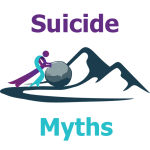Our programs broadly fit into four key categories:
Public Health
Improving the health of individuals through public, community level changes
Education
Compelling learning experiences that drive keystone behavior changes
Systems
Targeted interventions to shift larger systems
Means Restriction
Reducing access to means of suicide during suicidal crisis
Three major programs are in active development.
The World Health Organization (WHO) estimates that a million people die each year by suicide. Suicide is real, and it’s a real problem. However, many of the things that people believe about suicide are myths.
In the United States, less than 50% of guns are stored safely. By improving safe gun storage rates, we will reduce suicide rates and unauthorized use resulting in injury or fatality.
Drug overdoses represent substantial human life and medical costs. We aim to demonstrate the efficacy of home medication dispensers in improving chronic pain management and reducing suicide attempts.

Suicide Myths
The World Health Organization (WHO) estimates that a million people die each year by suicide. Suicide is real, and it’s a real problem. However, many of the things that people believe about suicide are myths. These myths keep us from understanding suicide and helping more people want to stay alive.
This site has a simple mission: to provide the truth about suicide when we know it and identify the myths that too many believe. We don’t believe we know everything about suicide or even everything there is to know about these suicide myths. That’s why each myth includes all the evidence about the myth – even if that evidence seems to contradict our conclusion.

Visit Us at SuicideMyths.org
Learn more about suicide myths – and the truths hidden behind them.

Safe Gun Storage
In the United States, multiple research studies indicate that less than 50% of guns are stored safely. It is believed that this lack of safe gun storage contributes to the high numbers of mass shooting events, unauthorized use, and firearm-related suicide in the U.S. Unauthorized use includes when children and youth gain access to firearms stored in their home, resulting in injury and fatalities. Safe gun storage has been shown to reduce suicide rates both for the owner and for others in the home. It has further been shown to reduce unauthorized use.
We propose to change the rate of safe gun storage. We will do this by intervening at two critical points in time, offering three approaches, and making it easier to access the resources available. The problem of safe gun storage is partially a knowledge problem, but predominantly an attitudes problem, where individuals, families, and communities don’t understand the risk associated with unsecured firearms in the home.
The first point in time to be addressed is when the firearm is being purchased. Every firearm purchase requires a background check. During this check, we will deliver two videos and ask a single question to encourage an understanding of the need for safe gun storage for unintended use, theft, and suicide. This will be followed by storage options and a carefully structured call to use them.
The primary objection to storing guns safely is the time needed to access the gun for personal or home protection. To indirectly combat this concern, we will hire a speed shooting champion to do the videos to subliminally convey that speed won’t be an issue. We do not believe directly addressing this concern is advisable or even possible.
The second point in time to be addressed is a point of crisis. This interaction will help individuals know how to keep themselves safe when they are struggling with mental health due to an external trauma. Contact will be prompted by law enforcement, other first responders, and mental health providers. The information delivered will start with safe gun storage but will continue with even greater degrees of time delayed access, such as storing combinations and keys in a rented post office box.
Firearm owners have three basic approaches for restricting access. There are standard safe storage options for homes. A more protective approach for times of crisis is to store combinations and keys in an off-site location. We are proposing a strategy that leverages post office boxes to store these keys and combinations because of the laws preventing tampering with mail. Finally, off-site storage options will be discussed.
Behavioral research has shown that people will rarely do things that are confusing. Although every new firearm comes with a cable lock and many programs exist to distribute additional cable locks, many firearms owners are uncomfortable with the use of these locks. To combat this, we will connect them with manufacturers’ materials for the proper use of cable locks with their firearms.
References
Alper, M., & Glaze, L. (2019). Source and Use of Firearms Involved in Crimes: Survey of Prison Inmates, 2016. Bureau of Justice Statistics. United States Department of Justic. Retrieved 05 04, 2023, from https://bjs.ojp.gov/content/pub/pdf/suficspi16.pdf
Azrael, D., Cohen, J., Salhi, C., & Miller, M. (2018). Firearm Storage in Gun-Owning Households with Children:. Journal of Urban Health, 95, 295-304.
Brewer Jr, J. W., Cox, C. S., Flecther, S. A., Shah, M. N., Sandberg, M., & Sandberg, D. I. (2019). Analysis of pediatric gunshot wounds in Houston, Texas: A social perspective. Journal of Pediatic Surgery, 54, 783-791.
Crifasi, C. K., Doucette, M. L., McGinty, E. E., Webster, D. W., & Barry, C. L. (2018, April). Storage Practices of US Gun Owners in 2016. American Journal of Public Health.
Kena, G., & Truman, J. (2022). Trends and Patterns in Firearm Violence, 1993-2018. Bureau of Justice Statistics. United States Department of Justice. Retrieved 05 04, 2023, from https://bjs.ojp.gov/content/pub/pdf/tpfv9318.pdf
Miller, M., Azrael, D., Hemenway, D., & Vriniotis, M. (2005). Firearm storage practices and rates of unintentional firearm deaths in the United States. Accident Analysis & Prevention, 37, 661-667.
National Safety Council. (n.d.). Car Crash Deaths and Rates. Retrieved from National Safety Council: https://injuryfacts.nsc.org/motor-vehicle/historical-fatality-trends/deaths-and-rates
Schwartz, B. (2004). The Paradox of Choice: Why More is Less. New York, NY: HarperCollins Publishers.
Sharp, L. (1952, Summer). Steel Axe Heads for Stone Age Australians. Human Organization, 11.
Shennasa, E. D., Rogers, M. L., Spalding, K. L., & Roberts, M. B. (2004). Safer Storage of Firearms at Home and Risk of Suicide: A Study of Protective Factors. Journal of Epidemiology and Community Health, 58(10), 841-848.
Thaler, R., & Sunstein, C. (2009). Nudge: Improving Decisions About Health, Wealth, and Happiness. New York, New York, USA: Penguin Group USA, Inc.

Medication Safety
Both substance use disorder (SUD) and suicide are serious and increasing problems in the United States. They’re inextricably linked, because it’s often impossible to determine whether and overdose was accidental or intentional. They represent substantial human life and medical costs.
In 2021, 106,699 drug overdose deaths occurred, resulting in an age-adjusted rate of 32.4 per 100,000. In 2001, the rate was 6.8 per 100,000 (Spencer, Miniño, & Warner, 2022). The economic estimate for the cost of the opioid epidemic in 2015 was $504 billion (The Council of Economic Advisors, 2017).
In 2020, there were 45,979 suicide deaths in the United States. Of these, 5,528 (12%) were due to poisoning – the third most prevalent category. The drug-related poisoning accounted for 4,329 (78%). The estimated cost of emergency room visits related to an attempted suicide in 2013 was $107 million (Owens, Fingar, Heslin, Mutter, & Booth, 2017).
In suicide prevention, there’s some debate about whether suicidal individuals will substitute means, with different studies having conflicting findings (Saigle, 2005). Studies around population level interventions, such as detoxification of gas, reformulation of fertilizers, and installation of bridge anti-suicide fences, seem to cause limited – if any – changes in other suicide means. It is more consistently supported that suicide attempts are reduced when access to means have been delayed (Florentine & Crane, 2010). This makes means prevention an essential part of a reduction strategy.
Home medication dispensers are now widely available with automatic dispensing, technological integrations, and tamper resistance. This combination of capabilities allows for the deployment of devices to provide appropriate access to medications while making overdose and suicidal use of medications difficult. However, these devices are not widely deployed because of the lack of demonstrated efficacy. This project is designed to close the gap in the literature and demonstrate the efficacy of home medication dispensers at improving chronic pain management and suicide attempt reduction.
References
Andrews, N. E., Ireland, D., Deen, M., & Varnfield, M. (2023). Clinical utility of a mHealth assisted intervention for activity modulation in chronic pain: The pilot implementation of pain ROADMAP. European Journal of Pain, 1-17.
Barry, C. L., McGinty, E. E., Pescosolido, B., & Goldman, H. H. (2014). Stigma, Discrimination, Treatment Effectiveness and Policy Support: Comparing Public Views about Drug Addiction with Mental Illness. Psychiatric Servicese, 65(10), 1269-1272. doi:doi:10.1176/appi.ps.201400140
Bogue, R. L. (2001). Mobilize Yourself! the Microsoft Guide to Mobile Technology. Redmond, Washington: Microsoft Press.
Clark, C. M., Snyder, J., Meek, R. L., Stutz, L. M., & Parkin, C. G. (2001). A Systematic Approach to Risk Stratification and Intervention Within a Managed Care Environment Improves Diabetes Outcomes and Patient Satisfaction. Diabetes Care, 24(6), 1079-1086.
Florentine, J. B., & Crane, C. (2010). Suicide prevention by limiting access to methods: A review of theory and practice. Social Science & Medicine, 70, 1626-1632.
Gaskin, D., & Richard, P. (2012). The Economic Costs of Pain in the United States. The Journal of Pain, 13(8), 715-722.
McGinty, E., Pescosolido, B., Kennedy-Hendricks, A., & Barry, C. (2018). Communications Strategies to Counter Stigma and Improve Mental Illness and Substance Use Disorder Policy. Psychiatric Services, 69, 136-146. doi:doi:10.1176/appi.ps.201700076
Miller, T. R., Swedler, D. I., Lawrence, B. A., Ali, B., Rockett, I. R., Carlson, N. N., & Leonardo, J. (2020). Incidence and Lethality of Suicidal Overdoses by Drug Class. Journal of the American Medical Association (JAMA), 3(3). doi:doi:10.1001/jamanetworkopen.2020.0607
Mustafa, A. S., Ali, N., Dhillon, J. S., Alkawski, G., & Baashar, Y. (2022). User Engagement and Bandonment of mHealth: A Cross-Sectional Survey. Healthcare, 10(221). doi:doi.org/10.3390/healthcare10020221
Owens, P. L., Fingar, K. R., Heslin, K. C., Mutter, R., & Booth, C. L. (2017). Emergency Department Visits Related to Suicidal Ideation, 2006-2013. Washington, DC: Agency for Healthcare Research and Quality. Retrieved 05 10, 2023, from https://www.ncbi.nlm.nih.gov/books/NBK442036/pdf/Bookshelf_NBK442036.pdf
Pescosolido, B. A., Martin, J. K., Long, J. S., Medina, T. R., Phelan, J. C., & Link, B. G. (2010). “A Disease Like Any Other”? A Decade of Change in Public Reactions to Schizophrenia, Depression, and Alcohol Dependence. American Journal of Psychiatry, 167(11), 1321-1330. doi:doi:10.1176/appi.ajp.2010.09121743
Saigle, M. S. (2005). Suicide prevention through means restriction: Assessing the risk of substitution: A critical review and synthesis. Accident Analysis and Prevention, 37(4), 625-632.
Spencer, M. R., Miniño, A., & Warner, M. (2022). Drug Overdose Deaths in the United States, 2001–2021. Center for Disease Control and Prevention, National Center for Health Statistics. Washington, DC: United States Department of Health and Human Services. Retrieved 05 10, 2023, from https://www.cdc.gov/nchs/data/databriefs/db457.pdf
The American Medical Association. (2022). Access to naloxone has increased, but remains limited by prescription status. The American Medical Association. Retrieved 05 12, 2023, from https://end-overdose-epidemic.org/wp-content/uploads/2022/09/Naloxone-dispensed-retail-pharmacy-state-by-state-2012-2021-FINAL.pdf
The Council of Economic Advisors. (2017). The Underestimated Cost of the Opioid Crisis. Washington, DC: Executive Office of the President of the United States. Retrieved 05 10, 2023, from https://www.hsdl.org/?view&did=806029
United States Federal Bureau of Investigation. (n.d.). Crime Data Explorer. Retrieved from Crime Data Explorer: https://cde.ucr.cjis.gov
United States Substance Abuse and Mental Health Services Administration. (2022, January 11). 2020 NSDUH Detailed Tables. Retrieved 05 12, 2023, from United States Substance Abuse and Mental Health Services Administration: https://www.samhsa.gov/data/report/2020-nsduh-detailed-tables



